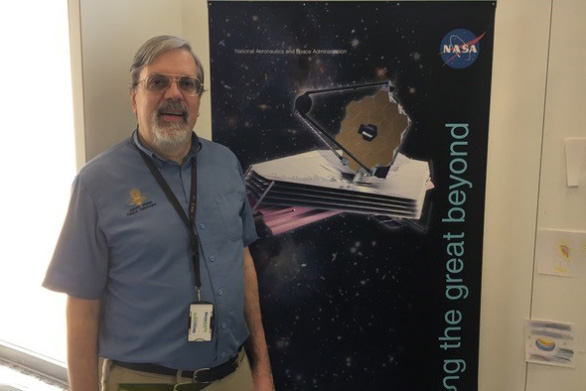Kevin Parker Reflects on his NASA Career and the Legacy of St. John’s Labs
August 1, 2022 | By Eve Tolpa

Back in 2019, Kevin Parker (A79), a software engineer who works with NASA, was having lunch with St. John’s College’s Senior Director of Advancement John Kane (AGI10, CFRE). “I mentioned to him that because of what the science program meant to me, I’d be interested in making a donation on the order of $50,000 in support of it,” says Parker.
Kane returned about a month later with a proposal created with input from Annapolis lab director Mark Daly and a couple of tutors. The idea was to replace that campus’s senior lab equipment, some of which dated back to the days when Parker and his wife, Tina Rhea (A79), were students.
“I met with the team to discuss the need and was convinced this was a worthy cause, then made donations in multiple installments in 2019 and 2020,” Parker explains. “There was a challenge match in effect at the time, the Winiarski Family Foundation Challenge, so the overall contribution was doubled, with the matching funds going to the St. John’s Endowment.”
Parker arranged to donate eight units each of two different types of equipment, both of which allow students to reproduce a key experiment from the history of particle physics. “The J.J. Thomson apparatus shows that atoms include tiny, negatively charged particles eventually dubbed electrons,” he says. “The photo-electric apparatus demonstrates [Einstein’s] photo-electric effect.”
Because the early days of the pandemic required remote learning, the new equipment was not initially available for in-person use. Instead, Daly says, students watched video demonstrations with commentary from tutors. It was only during the 2021–22 academic year, when classes met on campus again, that they were given direct access to the new apparatuses.
St. John’s science lab materials are always in need of an update, says Daly, who notes that microscopes (to give just one example) are continually improving in quality, and lab budgets only tend to allow for piecemeal replacement of equipment. “Kevin really helped us out a lot,” he adds. “I can’t say that enough. This new equipment is going to be around for a long time.”
As for Parker’s own experiences in the St. John’s labs, he says they gave him “a lot of confidence in speaking up.” He remembers his junior year when a tutor new to junior lab was leading the class for the first time ever. “I found that I was frequently a step ahead of him in understanding the material, so I’d have to speak up and clarify things,” Parker says. “Then together we’d work on explaining things to everyone else. That would be a bizarre experience at almost any other university.”
After graduating, those reference points translated into the assurance and drive for Parker to acquire specialized knowledge in science and software engineering, including a master’s in computer science from Johns Hopkins University and one in astronomy from James Cook University.
It has also continued as a hallmark of his approach to his work, which has long entailed presenting software reviews to what he calls “a crowd of skeptical NASA engineers and managers.” Says Parker, “Some of my coworkers have found that absolutely terrifying, but I’ve never had a problem with it, or with speaking up in a meeting when I think someone—no matter how senior—is wrong.”
For much of the new millennium up until March 2012, Parker worked on NASA’s James Webb Space Telescope (JWST), which succeeded the Hubble as the most powerful telescope ever launched into space. JWST released its first images to the public on July 12, and with its help, Parker says, “we’ll be able to characterize exoplanet atmospheres, to the point of being able to tell whether one has an industrial civilization by the pollutants in the atmosphere. We’ll be able to see through dust clouds and see stars and planets forming inside them.”
Since wrapping up his involvement with that project a decade ago, he has been working on the Joint Polar Satellite System (JPSS), an advanced weather detection system; prior to that he was involved with creating a prototype mission for JPSS, the Suomi NPP satellite, which launched in 2011.
Parker recounts one of the victories of that system. “In 2012 Tropical Storm Sandy was heading out to sea until it abruptly took a sharp left and slammed into New Jersey. Fortunately, forecasters saw that coming and residents had several days’ warning,” he says.
“Afterwards, meteorologists analyzed how they came up with that forecast and realized that without the data from Suomi, the turn would have come as a complete surprise, and New Jersey would have had hours of warning rather than days. So, I take some pride in that.”
Though Parker characterizes his view of the value of a liberal arts education for engineers as “kind of a cliché,” he nonetheless contends that it can lead to stronger moral and ethical grounding, not to mention interpersonal skills, which he employs frequently in his own career. These in particular he gained as a direct result of his undergraduate education, with “communication being a significant area of focus at St. John’s, with all of the verbal and written interaction that’s required.”
Parker is not the only one in his field who sees the benefit of that skillset. “Some people,” he says, “have suggested that if the engineers advising on the Challenger launch had been better communicators, they might have persuaded their superiors to postpone the launch—and therefore saved the crew and spacecraft.”

